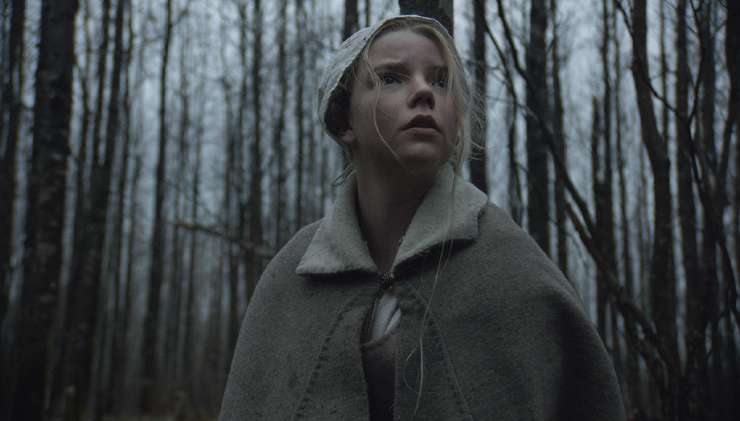Review: The Witch

Like most great horror movies, The Witch is smart enough to largely dispense with the “rules” of its genre. We see the film’s titular boogeywoman early on and with some clarity; we’re then led to believe that she may even be somewhat incidental to the plot, and that the true evil may be inside one of our seeming protagonists. There’s little gore and very little in the way of traditional “jump scares”–at least until it’s too late for The Witch to present itself as the kind of movie which traffics in such gimmicks. Instead of trying to engineer a shock-delivery system, The Witch opts for a slow-burning sense of dread echoing other great, unconventional horror flicks like Repulsion or The Shining.
The film is set in 1630 New England, as a family of seven is exiled from their Puritan colony for vaguely defined reasons related to the father’s (Ralph Ineson) “prideful” approach to spreading the word of God. The father, William, leads his brood to a spot just at the edge of a dark and expansive woodland and they begin to establish a homestead. Again neglecting typical genre practice, The Witch doesn’t allow us that typical dull period of calm when you’re waiting for the first scare to happen; we’re barely five minutes into the film before the newborn of the family vanishes during a game of peekaboo with capable teenaged daughter Thomasin (Anya Taylor-Joy). Cut to the unsettlingly premature appearance of the decaying witch (Bathsheba Garnett) in her hut, performing some unholy ritual over the infant.
But is she the witch? Our highly superstitious protagonists immediately begin to suspect and accuse each other of being responsible for the baby’s disappearance, as well as the string of other misfortunes that begin to befall their settlement. And it’s hard for us to blame them. There seems to be some kind of evil in just about every member of this family–from the young twins (Ellie Grainger and Lucas Dawson), who openly converse with a goat they call “Black Phillip,” to William himself, whose determination to make the new homestead succeed verges on the deranged.
The small cast is uniformly excellent, convincingly wrapping their tongues around the knotty period dialogue. Ineson exerts a terrific gravitational pull as the all-powerful father slowly losing his grip, and Taylor-Joy gives a fierce, sympathetic performance as she becomes the film’s ostensible lead. The performers expertly craft a growing sense of hysteria that piles up into a final half-hour of protractedly spine-tingling scenes.
Production designer Craig Lathrop and costume designer Linda Muir work hard to create an authentic period atmosphere that makes the family’s dogmatic mania all the more believable. Although the vast majority of the film takes place in isolation on the family’s homestead, brief glimpses of their old colony at the beginning of the film have the fascinating feel of real life. First-time feature director Robert Eggers and cinematographer Jarin Blaschke collaborate to create a striking visual sense for the proceedings. Cloudy skies are omnipresent in the film’s many exterior scenes, and the color palette emphasizes grays and browns that feel earthy even as they seem to forebode decay and death.
And that’s appropriate, because The Witch is a film about people deeply connected to the earth, dependent upon it, but also fighting against their true nature. At one point the mother, Kate (Kate Dickie), emphatically expresses her wish that the family had never left their native England. For all William’s professed desire to serve God, he’s consistently ignorant of the universe’s signs that he’s doing the wrong thing. The presence, and possible wrath, of Native Americans hovers around the story as well. Local natives are seen for a fleeting but significant moment in an early scene, and a trade William made with them becomes a point of some contention among the family later in the story.
It’s easy to try to read The Witch as a theological text on the relative merits of the Christian God and Satan; the New York-based Satanic Temple, which has wholeheartedly endorsed the film, certainly seems to think so. But no. The film is about invaders trying to impose their will upon a land that was never theirs, and the land taking its own back. The Witch suggests a fundamental sin at the root of American history. Even more so than the standard genre tropes of a cabin at the edge of a creepy woods, or the old standby of God versus the devil, there’s true horror in that idea for any American.
Patrick Dunn is an Ann Arbor-based freelance writer whose work appears regularly in the Detroit News, the Ann Arbor Observer, and other local publications. He can be heard most Friday mornings at 8:40 am on the Martin Bandyke morning program on Ann Arbor's 107one.
The Witch opens in wide release this weekend.


































